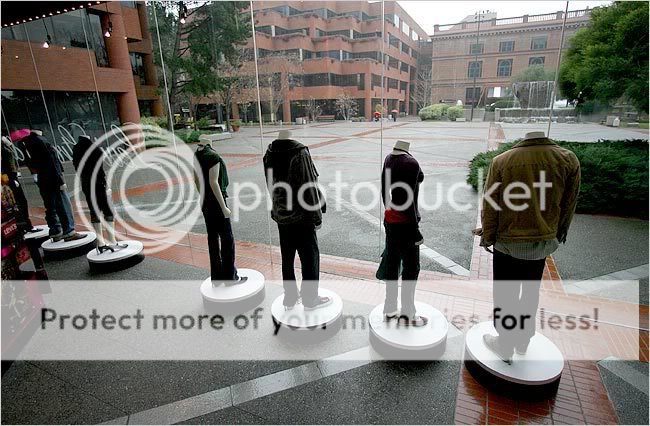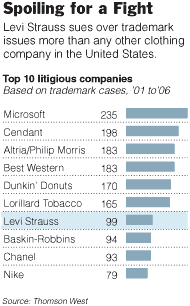DosViolines
far from home...
- Joined
- Aug 21, 2005
- Messages
- 3,217
- Reaction score
- 12
nytimes
January 29, 2007
Levi’s Turns to Suing Its Rivals

Jim Wilson/The New York Times
Levi’s designers worked on jeans at the company's headquarters.
By MICHAEL BARBARO and JULIE CRESWELL
United States Patent and Trademark No. 1,139,254 is not much to look at: a pentagon surrounding a childlike drawing of a seagull in flight.
But the design for a Levi’s pocket, first used 133 years ago, has become the biggest legal battleground in American fashion.
Levi Strauss claims that legions of competitors have stolen its signature denim stitches — two intersecting arcs and a cloth label — for their own pockets, slapping them on the seats of high-priced, hip-hugging jeans that have soared in popularity.
So Levi’s is becoming a leader in a new arena: lawsuits. The company, once the undisputed king of denim and now a case study in missed opportunities, has emerged as the most litigious in the apparel industry when it comes to trademark infringement lawsuits, firing off nearly 100 against its competitors since 2001. That’s far more than General Motors, Walt Disney or Nike, according to an analysis by research firm Thomson West.
The legal scuffles offer a rare glimpse into the sharp-elbowed world of fashion, where the line between inspiration and imitation is razor thin. After all, clothing makers’ trade secrets are hung on store racks for all to see, and designs can be quickly copied with small changes to exploit a hot trend.
The lawsuits, which Levi’s says it is compelled to file to safeguard the defining features on its jeans, are not about the money — one settled for just $5,000 in damages. Instead, the company says, they are about removing copycats from stores. Nearly all the cases have settled out of court, with Levi’s smaller rivals agreeing to stop making the offending pants and to destroy unsold pairs.
But those competitors say the lawsuits are the last resort of a poor loser, a company that has lost billions in sales, laid off thousands of workers and flirted with bankruptcy as the denim industry exploded.
“They missed the boat,” said Tonny Sorensen, chief executive of Von Dutch Originals, a six-year-old denim and clothing manufacturer sued by Levi’s six months ago for allegedly borrowing the company’s double arcs for a back-pocket design. “Now they want to make a lot of noise and scare people away.”
Mr. Sorensen said his pocket design “did not look like Levi’s at all” because of subtle differences like placing the arcs “one inch to the left” and stitching a line to resemble “a pirate’s hook.”
Nevertheless, Von Dutch agreed to remove the jeans from dozens of boutiques and destroy hundreds of unsold pairs. “It was one style and it was not that successful anyway, so we made the decision not to fight it,” Mr. Sorensen said.
In the majority of cases, Levi’s accuses competitors of copying its design of two arcs that meet in the center of the pocket or its famous Levi’s tab, a folded piece of cloth sewn into the vertical seam of the garment.
Robert Hanson, Levi’s president for North America, said the company manufactured “a product that a lot of people are copying and copying with a lot of success.”
Instead of relying on Levi’s designs for what he called a “running start,” competitors should “look for other devices that don’t come remotely close to the Levi’s trademarks,” Mr. Hanson said. “Be more innovative.”
But the privately held Levi’s, whose founder sewed together the first pair of jeans in 1873, has been unable to exploit the latest $200-a-pair denim craze — and now claims scores of smaller competitors are riding high because of what it created. When consumers’ tastes shifted toward designer jeans that were bejeweled, torn and frayed, Levi’s was still selling basic $30 pairs at K-Mart.
In this dispute, back-pocket stitching has become the fashion equivalent of ink blots, with plaintiffs and defendants seeing in the new designs what they want, or need, to see. So far, Levi’s view is prevailing.
The company’s team of denim detectives — there are 40 across the world, scouring boutiques and department stores — has spotted what they considered offending stitches on jeans from the biggest names in the clothing business: Guess, Zegna, Esprit, Lucky Brand and Zumiez, to name a few.
Even companies that have painstakingly worked to avoid infringing on Levi’s trademarks have found themselves in the company’s crosshairs. At Rock & Republic, one of the country’s fastest-growing jeans makers, designers intentionally placed a cloth label on the right hand side of a back pocket, not the left, which would violate a Levi’s trademark.
Levi’s sued anyway, arguing its trademarks forbid placing such a label on a vertical seam of a back-pocket. During a tense, five-hour settlement discussion in San Francisco several weeks ago, the chief executive of Rock and Republic, Michael Ball, upbraided Levi’s lawyers for their aggressive tactics.
“I take it personally that you try to dictate how I design my jeans,” he recalled saying. Still, Mr. Ball said he agreed to stop placing the label on the vertical seam of a right-hand pocket for two years to avoid a drawn-out legal battle.
In an interview, Mr. Ball said his back-pocket stitching “was not remotely close to Levi’s” and that he agreed to a settlement, in part, because “I will get bored with that design soon anyway.”
Executives at Levi’s concede they missed important fashion trends as the denim industry ballooned over the last several years, but they deny the lawsuits are connected to any downturn in their business.
Instead, they say they are simply trying to preserve their intellectual property. Like pharmaceutical companies that sue generic drug makers over their patents or technology companies that duke it out over who owns the right to microchip designs, Levi’s says it is trying to protect its most valuable asset, its trademarks.
Clothing companies have battled counterfeiters and each other for decades over design trademarks. Lacoste has defended its alligator, Polo Ralph Lauren fights for its polo player and Nike fiercely protects its famous swoosh.
In that respect, Levi’s is no different. As far back as the 1970s, it sued the firm that made Wrangler jeans over the use of identifying tabs on clothing. “We protected our trademarks when business has been terrific and when it’s been difficult,” said Mr. Hanson.
Yet difficult only begins to describe Levi’s business today, after it failed to exploit the designer denim boom in what is widely regarded as one of the biggest debacles in the American clothing business. Levi’s sales have plummeted more than 40 percent since 1996 to $4.1 billion, forcing it to close dozens of factories and lay off nearly half of its workforce, or 7,600 employees, in the last five years.
The clothing company faced two major problems over the last decade. Its image and brand — button fly, rugged, and all-around bad-boy cool — was largely built for men, its jeans cut boxy and loose- fitting. At the same time, the company, which once distributed its jeans largely through department stores catering to the rich, had shifted into lower-priced retailers like J.C. Penney, Sears and Wal-Mart.
In the mid-1990s, though, the denim industry underwent a seismic shift as small upstarts began designing tight-fitting, feature-flattering women’s jeans and distributing them through luxury boutiques and department stores.
Women suddenly began snapping up jeans from manufacturers like 7 for All Mankind and True Religion that cost more than six times what Levi’s charged. Levi’s did not produce a premium denim line, Capital E, until just last year.
“The emergence of all this denim sold at astronomical prices simply passed them by,” said David Wolfe, creative director of the Doneger Group, a fashion consulting firm in Manhattan. “They should have jumped on the bandwagon but they did not even seem to see the bandwagon rolling, which amazed everyone in the fashion industry.”
The denim manufacturers who recognized the trend openly concede that Levi’s has served as an inspiration, if not template, for their products.
“Everyone is borrowing from them, it’s inevitable,” said Michael Silver, the founder of Silver Jeans, who has had several legal run-ins with Levi’s. “They should be happy that people are copying them,” he said.
But Levi’s is not flattered. “The value of the brand will become diluted if the marketplace becomes crowded with products with similar tabs or stitching to ours,” said Thomas M. Onda, a global intellectual property lawyer for Levi’s.
So employees at Levi’s keep walking into stores and scanning the racks for rivals who dare to stray to close its trademarks, as Steven Shaul, the founder and chief executive of Jelessy Jeans, learned when he slapped several intersecting arcs on a back pocket.
At the time, Mr. Shaul, who loves Levi’s and wears its jeans all the time, was confident his design bore no resemblance to the Levi’s trademark. “It was not even close,” said Mr. Shaul, whose jeans sell for between $200 and $400 a pair.
“It was an original design,” he said. “Why would I use Levi’s stitching? If my jeans sell for $200, I would not knock off $40 jeans from Levi’s.”
Nevertheless, Levi’s sued in 2005. “The first night after I was sued by them I couldn’t sleep,” he said. “The second night, no sleep again. Then I started talking to people in the industry and I realized, hey, everyone’s been sued by Levi.”
Relieved, he quickly settled the case, agreeing not to sell jeans with the offending stitches. “I did not even hire a lawyer,” he said.

Jim Wilson/The New York Times
[SIZE=-1]The original design for a Levi’s pocket, first used 133 years ago, has become the biggest legal battleground in American fashion.

[/SIZE][SIZE=-1]Four companies Levi Strauss has sued, clockwise from top left: Jones Apparel, Von Dutch, Jelessy and Karen Kane.

[/SIZE][SIZE=-1]Levi Strauss headquarters in San Francisco. The company, once the undisputed king of denim and now a case study in missed opportunities, has emerged as the most litigious in the apparel industry.

[/SIZE]Jim Wilson/The New York Times
[SIZE=-1]The company has a team of denim detectives who scan the racks for rivals who dare to stray too close its trademarks.

[/SIZE]Jim Wilson/The New York Times
[SIZE=-1]Levi’s has been unable to exploit the latest $200-a-pair denim craze. When consumers’ tastes shifted toward designer jeans that were bejeweled, torn and frayed, Levi’s was still selling basic $30 pairs at K-Mart.

[/SIZE]Jim Wilson/The New York Times
[FONT=Arial, Helvetica, San Serif][SIZE=-1]Mannequins line the lobby windows of Levi's headquarters. Levi’s sales have plummeted more than 40 percent since 1996 to $4.1 billion, forcing it to close dozens of factories and lay off nearly half of its workforce in the last five years.

[/SIZE][/FONT]

